Related Research Articles
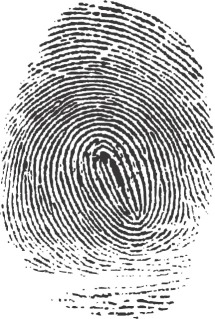
A fingerprint is an impression left by the friction ridges of a human finger. The recovery of partial fingerprints from a crime scene is an important method of forensic science. Moisture and grease on a finger result in fingerprints on surfaces such as glass or metal. Deliberate impressions of entire fingerprints can be obtained by ink or other substances transferred from the peaks of friction ridges on the skin to a smooth surface such as paper. Fingerprint records normally contain impressions from the pad on the last joint of fingers and thumbs, though fingerprint cards also typically record portions of lower joint areas of the fingers.
Biometrics are body measurements and calculations related to human characteristics and features. Biometric authentication is used in computer science as a form of identification and access control. It is also used to identify individuals in groups that are under surveillance.
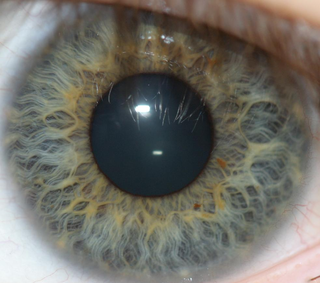
Iris recognition is an automated method of biometric identification that uses mathematical pattern-recognition techniques on video images of one or both of the irises of an individual's eyes, whose complex patterns are unique, stable, and can be seen from some distance. The discriminating powers of all biometric technologies depend on the amount of entropy they are able to encode and use in matching. Iris recognition is exceptional in this regard, enabling the avoidance of "collisions" even in cross-comparisons across massive populations. Its major limitation is that image acquisition from distances greater than a meter or two, or without cooperation, can be very difficult. However, the technology is in development and iris recognition can be accomplished from even up to 10 meters away or in a live camera feed.

A facial recognition system is a technology potentially capable of matching a human face from a digital image or a video frame against a database of faces. Such a system is typically employed to authenticate users through ID verification services, and works by pinpointing and measuring facial features from a given image.
Multimodal interaction provides the user with multiple modes of interacting with a system. A multimodal interface provides several distinct tools for input and output of data.
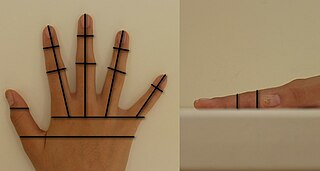
Hand geometry is a biometric that identifies users from the shape of their hands. Hand geometry readers measure a user's palm and fingers along many dimensions including length, width, deviation, and angle and compare those measurements to measurements stored in a file.
Keystroke dynamics, keystroke biometrics, typing dynamics, ortyping biometrics refer to the collection of biometric information generated by key-press-related events that occur when a user types on a keyboard. Use of patterns in key operation to identify operators predates modern computing, and has been proposed as an authentication alternative to passwords and PIN numbers.
Plagiarism detection or content similarity detection is the process of locating instances of plagiarism or copyright infringement within a work or document. The widespread use of computers and the advent of the Internet have made it easier to plagiarize the work of others.
Private biometrics is a form of encrypted biometrics, also called privacy-preserving biometric authentication methods, in which the biometric payload is a one-way, homomorphically encrypted feature vector that is 0.05% the size of the original biometric template and can be searched with full accuracy, speed and privacy. The feature vector's homomorphic encryption allows search and match to be conducted in polynomial time on an encrypted dataset and the search result is returned as an encrypted match. One or more computing devices may use an encrypted feature vector to verify an individual person or identify an individual in a datastore without storing, sending or receiving plaintext biometric data within or between computing devices or any other entity. The purpose of private biometrics is to allow a person to be identified or authenticated while guaranteeing individual privacy and fundamental human rights by only operating on biometric data in the encrypted space. Some private biometrics including fingerprint authentication methods, face authentication methods, and identity-matching algorithms according to bodily features. Private biometrics are constantly evolving based on the changing nature of privacy needs, identity theft, and biotechnology.
The Facial Recognition Technology (FERET) program was a government-sponsored project that aimed to create a large, automatic face-recognition system for intelligence, security, and law enforcement purposes. The program began in 1993 under the combined leadership of Dr. Harry Wechsler at George Mason University (GMU) and Dr. Jonathon Phillips at the Army Research Laboratory (ARL) in Adelphi, Maryland and resulted in the development of the Facial Recognition Technology (FERET) database. The goal of the FERET program was to advance the field of face recognition technology by establishing a common database of facial imagery for researchers to use and setting a performance baseline for face-recognition algorithms.

Vein matching, also called vascular technology, is a technique of biometric identification through the analysis of the patterns of blood vessels visible from the surface of the skin. Though used by the Federal Bureau of Investigation and the Central Intelligence Agency, this method of identification is still in development and has not yet been universally adopted by crime labs as it is not considered as reliable as more established techniques, such as fingerprinting. However, it can be used in conjunction with existing forensic data in support of a conclusion.
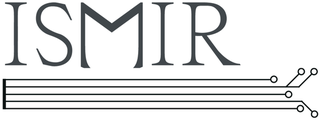
The International Society for Music Information Retrieval (ISMIR) is an international forum for research on the organization of music-related data. It started as an informal group steered by an ad hoc committee in 2000 which established a yearly symposium - whence "ISMIR", which meant International Symposium on Music Information Retrieval. It was turned into a conference in 2002 while retaining the acronym. ISMIR was incorporated in Canada on July 4, 2008.
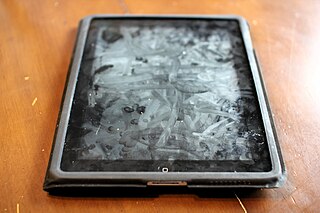
A smudge attack is an information extraction attack that discerns the password input of a touchscreen device such as a cell phone or tablet computer from fingerprint smudges. A team of researchers at the University of Pennsylvania were the first to investigate this type of attack in 2010. An attack occurs when an unauthorized user is in possession or is nearby the device of interest. The attacker relies on detecting the oily smudges produced and left behind by the user's fingers to find the pattern or code needed to access the device and its contents. Simple cameras, lights, fingerprint powder, and image processing software can be used to capture the fingerprint deposits created when the user unlocks their device. Under proper lighting and camera settings, the finger smudges can be easily detected, and the heaviest smudges can be used to infer the most frequent input swipes or taps from the user.

Signature recognition is an example of behavioral biometrics that identifies a person based on their handwriting. It can be operated in two different ways:
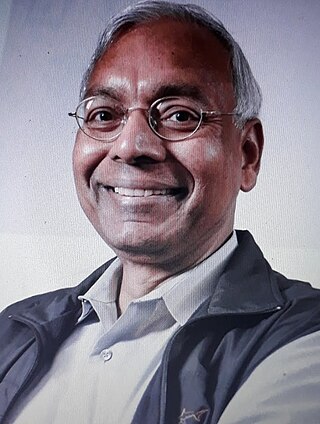
Anil Kumar Jain is an Indian-American computer scientist and University Distinguished Professor in the Department of Computer Science & Engineering at Michigan State University, known for his contributions in the fields of pattern recognition, computer vision and biometric recognition. He is among the top few most highly cited researchers in computer science and has received various high honors and recognitions from institutions such as ACM, IEEE, AAAS, IAPR, SPIE, the U.S. National Academy of Engineering, the Indian National Academy of Engineering and the Chinese Academy of Sciences.
Eye vein verification is a method of biometric authentication that applies pattern-recognition techniques to video images of the veins in a user's eyes. The complex and random patterns are unique, and modern hardware and software can detect and differentiate those patterns at some distance from the eyes.
Physical unclonable function (PUF), sometimes also called physically unclonable function, is a physical entity that is embodied in a physical structure and is easy to evaluate but hard to predict.

A biometric device is a security identification and authentication device. Such devices use automated methods of verifying or recognising the identity of a living person based on a physiological or behavioral characteristic. These characteristics include fingerprints, facial images, iris and voice recognition.
Jianchang (JC) Mao is a Chinese-American computer scientist and Vice President, Google Assistant Engineering at Google. His research spans artificial intelligence, machine learning, computational advertising, data mining, and information retrieval. He was named a Fellow of the Institute of Electrical and Electronics Engineers (IEEE) in 2012 for his contributions to pattern recognition, search, content analysis, and computational advertising.
Identity replacement technology is any technology that is used to cover up all or parts of a person's identity, either in real life or virtually. This can include face masks, face authentication technology, and deepfakes on the Internet that spread fake editing of videos and images. Face replacement and identity masking are used by either criminals or law-abiding citizens. Identity replacement tech, when operated on by criminals, leads to heists or robbery activities. Law-abiding citizens utilize identity replacement technology to prevent government or various entities from tracking private information such as locations, social connections, and daily behaviors.
References
- D. Maio, D. Maltoni, R. Cappelli, J.L. Wayman and A.K. Jain, "FVC2000: Fingerprint Verification Competition", IEEE Transactions on Pattern Analysis Machine Intelligence, vol.24, no.3, pp.402-412, March 2002.
- D. Maio, D. Maltoni, R. Cappelli, J.L. Wayman and A.K. Jain, "FVC2002: Second Fingerprint Verification Competition", in proceedings 16th International Conference on Pattern Recognition (ICPR2002), Québec City, vol.3, pp.811-814, August 2002.
- D. Maio, D. Maltoni, R. Cappelli, J.L. Wayman and A.K. Jain, "FVC2004: Third Fingerprint Verification Competition", in proceedings International Conference on Biometric Authentication (ICBA04), Hong Kong, pp.1-7, July 2004.
- R. Cappelli, D. Maio and D. Maltoni, "Technology Evaluations of Fingerprint-Based Biometric Systems", in proceedings 12th European Signal Processing Conference (EUSIPCO2004), Vienna, Austria, pp.1405-1408, September 2004.
- D. Maio, D. Maltoni, R. Cappelli, J.L. Wayman and A.K. Jain, "Technology Evaluation of Fingerprint Verification Algorithms", in J.L. Wayman, A.K. Jain, D. Maltoni, D. Maio, Biometric Systems - Technology, Design and Performance Evaluation, Springer, 2005.
- R. Cappelli, D. Maio, D. Maltoni, J.L. Wayman and A.K. Jain, "Performance Evaluation of Fingerprint Verification Systems", IEEE Transactions on Pattern Analysis Machine Intelligence, vol.28, no.1, pp.3-18, January 2006.
- R. Cappelli, M. Ferrara, A. Franco and D. Maltoni, "Fingerprint verification competition 2006", Biometric Technology Today, vol.15, no.7-8, pp.7-9, August 2007.
- B. Dorizzi, R. Cappelli, M. Ferrara, D. Maio, D. Maltoni, N. Houmani, S. Garcia-Salicetti and A. Mayoue, "Fingerprint and On-Line Signature Verification Competitions at ICB 2009", in proceedings International Conference on Biometrics (ICB), Alghero, Italy, pp.725-732, June 2009.